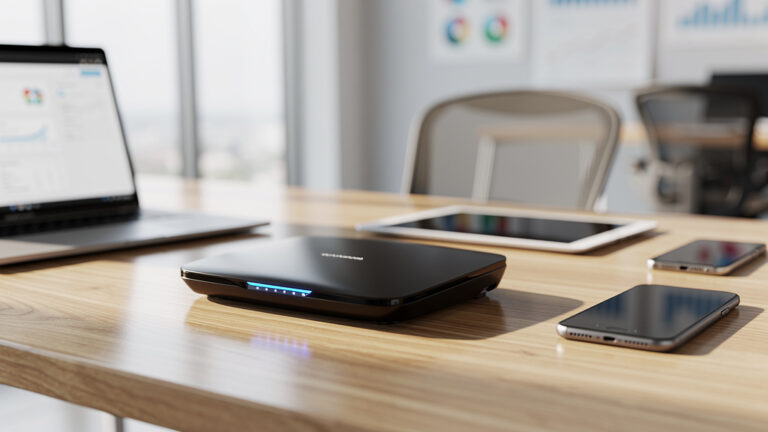An orange light on the TP-Link router’s internet icon typically signals a connectivity issue, indicating that while the internet port is connected, the router is failing to establish a stable connection with the Internet Service Provider (ISP).
Don’t worry, though! In this article, we’ll explore the common causes behind this problem and provide you with easy, step-by-step solutions to get your router back up and running in no time.
Common Causes of the TP-Link Orange Light
Before we dive into the fixes, let’s take a look at some of the most frequent culprits behind the dreaded orange light:
- Outdated firmware: Over time, your router’s firmware may become outdated, leading to compatibility issues and connectivity problems.
- Software glitches: Occasional bugs or glitches in the router’s software can disrupt the internet connection.
- Damaged Ethernet cables: Loose, frayed, or damaged Ethernet cables can prevent your router from establishing a stable connection with your modem.
- ISP outages: Sometimes, the issue lies with your Internet Service Provider (ISP). Scheduled maintenance or unexpected outages can cause temporary connectivity issues.
- Hardware issues: In rare cases, a malfunctioning router or modem may be the source of the problem.
See also: TP-Link Router Lights
Easy At-Home Fixes for TP-Link Orange Light
Now that we’ve identified the potential causes, let’s explore some simple troubleshooting steps you can try at home to resolve the orange light issue.
Before troubleshooting, make sure the modem has internet access by connecting it directly to a computer with an Ethernet cable. This will help identify any device or connection issues.
If the computer can access the internet with a direct connection, it means the modem is working fine, and if you still see the orange light , then keep on troubleshooting starting from point 1 below. If the computer has no internet access, it means a problem on the ISP side, and for that, check for ISP outages and wait for it to clear.
1. Restart the Router
One of the easiest and most effective ways to fix connectivity issues is to restart your router. But first, let’s clarify the difference between a restart and a power cycle:
- A restart involves turning the router off and on again using the power button.
- A power cycle requires you to unplug the router from its power source, wait a few minutes, and then plug it back in.
To perform a power cycle:
- Unplug your TP-Link router from the power outlet.
- Wait for 1-2 minutes to allow the router to fully discharge.
- Plug the router back into the power outlet.
- Wait for the router to restart and see if the orange light has turned white or green.
Additionally I would also recommend to restart your PC or phone or tablet to refresh the connection properly.
2. Check Cable Connections
Loose or damaged cable connections can often lead to internet connectivity issues. Follow these steps to ensure your cables are properly connected:
- Check that the Ethernet cable connecting your modem to the router’s WAN port is securely plugged in at both ends.
- Inspect the cable for any visible signs of damage, such as fraying or kinks. Replace the cable if necessary.
- Make sure the Ethernet cables connecting your devices to the router’s LAN ports are firmly plugged in.
3. Remove Physical Obstructions
Physical obstructions near your router can interfere with its wireless signal, potentially causing the orange light issue. To optimize your router’s performance:
- Place your TP-Link router in a central, open location away from walls and large metal objects.
- Keep the router away from other electronic devices that may cause interference, such as cordless phones or microwaves.
- Ensure the router has proper ventilation to prevent overheating.
4. Check for ISP Outages
Sometimes, the problem may lie with your ISP rather than your router. ISP outages, whether due to maintenance or unexpected issues, can result in temporary loss of internet connectivity. To check for outages:
- Visit your ISP’s official website or social media pages (Twitter or X page) to see if they’ve reported any known issues in your area.
- Contact your ISP’s customer support to inquire about potential outages and estimated resolution times.
5. Update Router Firmware
Keeping your router’s firmware up to date is crucial for maintaining optimal performance and security. New firmware versions often include bug fixes and improvements that can resolve connectivity issues. To update your TP-Link router’s firmware:
- Connect your computer to the router using an Ethernet cable.
- Open a web browser and enter your router’s default IP address (usually 192.168.0.1 or 192.168.1.1) in the address bar.
- Log in to your router’s web-based management page using your admin username and password.
- Navigate to the firmware update section and follow the on-screen instructions to check for and install any available updates.
Check the router’s status through its admin interface, it might offer insights and additional valuable information. For example, you can check the number of connected devices, internet connection status, and any recent error logs that may help diagnose the issue.
6. Factory Reset the Router
If none of the above steps resolve the orange light issue, you may need to perform a factory reset of the TP-link router. Keep in mind that this process will erase all your custom settings, so consider it a last resort. To factory reset your TP-Link router:
- Locate the small reset button on the back of your router.
- Using a paperclip or similar object, press and hold the reset button for 10-15 seconds until the router’s lights start flashing.
- Release the button and wait for the router to restart.
- Set up your router again from scratch using the default login credentials.
7. Clone the Router MAC Address
In some cases, cloning the MAC address from your old router to your new TP-Link router can resolve connectivity issues. This is particularly helpful if your ISP has registered your old router’s MAC address. To clone the MAC address:
- Log in to your old router’s web-based management page and navigate to the status page to find its MAC address.
- Log in to your new TP-Link router’s management page and go to the network settings.
- Look for the MAC address field or MAC Clone option.
- Enter your old router’s MAC address and save the changes.
When to Contact TP-Link Support
If you’ve tried all the above troubleshooting steps and still see the orange light on your TP-Link router, it may be time to reach out to TP-Link’s customer support for further assistance. To contact TP-Link support:
- Visit the official TP-Link website and navigate to the support section.
- Look for contact options such as a support ticket system, live chat, or phone number.
- Provide the support representative with details about your router model, the steps you’ve already tried, and any error messages you’ve encountered.
Conclusion
The orange light on your TP-Link router can be frustrating, but it’s usually an indication of a solvable connectivity issue. By understanding the common causes and following the troubleshooting steps outlined in this article, you can often resolve the problem on your own. Remember to check your cable connections, update your firmware, and remove any physical obstructions. If the issue persists, don’t hesitate to reach out to TP-Link’s customer support for further guidance.
FAQs
Q: How long should it take for my TP-Link router to connect after a restart?
A: Typically, your TP-Link router should reestablish an internet connection within 1-2 minutes after a restart. If it takes longer or the orange light persists, there may be an underlying issue that requires further troubleshooting.
Q: What does a solid white or green light on my TP-Link router mean?
A: A solid white or green light on your TP-Link router usually indicates a stable internet connection. If you see this light, your router is successfully connected to the internet, and you should be able to browse the web and use online services without any issues.
- 10 Best Network Switches for Home Networks in 2026 (Top Picks) - December 24, 2025
- 7 Best Budget Routers For Small Business Networks (Under $200) - December 22, 2025
- How to Configure a Secure Site-to-Site VPN on Cisco Firepower Complete Guide - December 3, 2025



